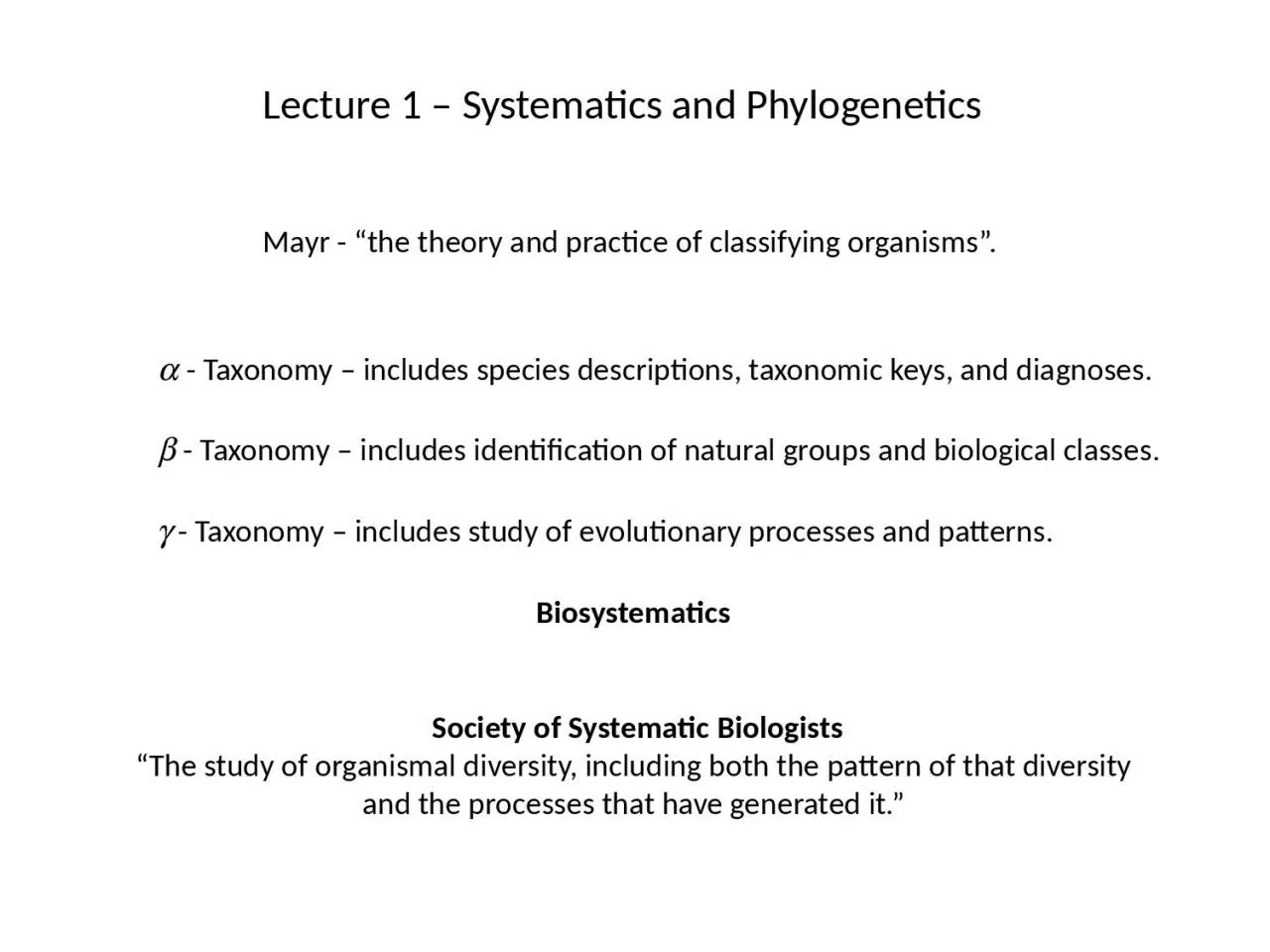

Mayr the theory and practice of classifying organisms a Taxonomy includes species descriptions taxonomic keys and diagnoses b Taxonomy includes identification of natural groups and biological classes ID: 933476
Download Presentation The PPT/PDF document "Lecture 1 – Phylogenetics and Systemat..." is the property of its rightful owner. Permission is granted to download and print the materials on this web site for personal, non-commercial use only, and to display it on your personal computer provided you do not modify the materials and that you retain all copyright notices contained in the materials. By downloading content from our website, you accept the terms of this agreement.
Slide1
Lecture 1 – Phylogenetics and Systematics
Mayr - “the theory and practice of classifying organisms”.
a-Taxonomy – includes species descriptions, taxonomic keys, and diagnoses.
b-Taxonomy – includes identification of natural groups and biological classes.
g-Taxonomy – includes study of evolutionary processes and patterns.
Biosystematics
Society of Systematic Biologists
“The study of organismal diversity, including both the pattern of that diversity
and the processes that have generated it.”
Slide2II. Roles of Systematics.
A. Provide a
-taxonomy.
There may be ~ 5-10 million extant species of
macrobes
on Earth (Costello et al. 2013), and we’ve only described 1.5 million (maybe around 18 %) of them.
57% of the 150 most prescribed drugs contain active ingredients derived
from natural compounds.
B. Provide specimen identification
Indirectly, via keys.
Directly, via expert examination.
There may be ~1 trillion extant species of microbes on Earth (
Locey
and Lennon 2016).
Slide3II. Roles of Systematics.
C. Maintain Collections
Provide reference for identifications.
Serve as permanent repository for important specimens.
Type specimens
Voucher specimens
Physical evidence of range shifts
Slide4II. Roles of Systematics.
D. Classification
Provide a hierarchy of names that is universal and that serves as the infrastructure for communication about biodiversity.
This must reflect evolutionary history – monophyletic groups
It also must be stable (we should resist change).
Do we want taxonomic ranks to be equilibrated across groups?
Pauley et al. (2009) versus Patterson & Norris (2016).
Slide5III. Roles of Phylogenies.
Google Scholar “phylogeny
” >1,150,000 papers published.
Slide6III. Roles of Phylogenies.
1. Understanding Adaptation
Placenta evolution in Eutherian mammals.
Moderately Efficient
Endotheliochorial
Least Efficient Epithelioichorial Most EfficientHemochorial
Wildman et al. (2006. PNAS, 103:3203-3208)
Slide7III. Roles of Phylogenies.
1. Understanding Adaptation
Placenta evolution in Eutherian mammals.
The less efficient placentae are the derived states and we need to explain their evolution
from hemochorial ancestors.
Moderately EfficientEndotheliochorial
Least Efficient
Epithelioichorial
Most Efficient
Hemochorial
Slide8III. Roles of Phylogenies.
2. Co-speciation, for example between parasites and their hosts.Hughes et al., 2007. Syst. Biol. 56:232 Nearly perfect congruence indicates a long history of co-speciation, with just two hypothesized
host-switching events.
Bellec
et al., 2014. BMC
Evol. Biol., 14:59 Sometimes it’s not the case, as in this study of algae and viruses.A whole host of methods have been developed to infer co-speciation, host shifts, etc. from comparisons of host and parasite phylogenies where they’re messy like this.
Slide93. Gene Family Evolution
Gene duplication is a common source of genetic variation, and lots of important proteins are coded by genefamilies.The only way to reconstruct the history of gene/genome duplication is via phylogenetic analyses, as show here forCoronin.This represents a phylogeny of the Coronin family and there have been at least 4 duplication events within vertebrates.
Morgan and Fernandez (2008. in
The Coronin Family of Proteins, Clemen et al., eds).
III. Roles of Phylogenies.
Slide104. Correlated Traits/Characters
Chen & Weins reconstructed the evolution of both acoustic communication and nocturnality in vertebrates. Acoustic communication evolved 4 times independently, each time in an ancestor that is reconstructed to have been nocturnal. Chen & Weins. 2020. Nature Comm. 11:359
Acoustic communication &nocturnalty.
III. Roles of Phylogenies.
Slide115. Diversification Rates(Speciation – Extinction)
A: Constant RateB: Early BurstC: Long Fuse
(Myers & Burbrink. 2012. Nature Education Knowledge 3:23).
Same topology, but
different branch lengths.
Lineages throughtime plots.III. Roles of Phylogenies.
Slide126. Conservation: Phylogenetic Diversity
Two Cool Local FrogsRana luteiventris
Ascaphus
montanus
The genus has no close relatives.
There are lots of close relatives.Extinction of tailed frogs would deplete phylogenetic diversity far more than extinction of Columbia spotted frogs.
Feng et al. (2017. PNAS, 114:E5864)
III. Roles of Phylogenies.
Slide13Current Coronavirus
7. Human Health - Origin of Pathogens III. Roles of Phylogenies.
It’s most closely related to SARS.
It has been transmitted from bats.
Slide14Phylogenetic effects of immune
escape.Phylogeny of influenza A (H3N2) from viruses sampled
between 1968 and 2002.Volz et al. (2013. PLoS Comp. Biol.doi:10.1371/journal.pcbi.1002947.g001)
7. Human Health - Viral Phylodynamics
III. Roles of Phylogenies.
Slide15HIV transmission in Edinburgh
Inferred that two donors infected the blood supply.
Holmes et al. (1995. J. Infect. Diseases, 171:45)
HIV
+ hemophiliacs formed twoseparate clades.
7. Human Health - Molecular EpidemiologyIII. Roles of Phylogenies.
Heterosexuals were contracting
HIV from IV Drug users.
Slide16III. Roles of Phylogenies.
8. Forensicshttp://
www.genomenewsnetwork.org/articles/01_03/hiv.shtml
Schmidt was accused of intentionally injecting Trahan with HIV he
collected from his HIV
+ patients.
Louisiana v. Richard J. Schmidt
This allegation predicts that HIV collected from Trahan should be very
closely related to HIV collected from one or more of his patients.
Richard Schmidt, M.D.
Janice Trahan
Slide17Trahan’s HIV
This (along with other evidence) lead to Schmidt’s conviction.
III. Roles of Phylogenies.
8. Forensics